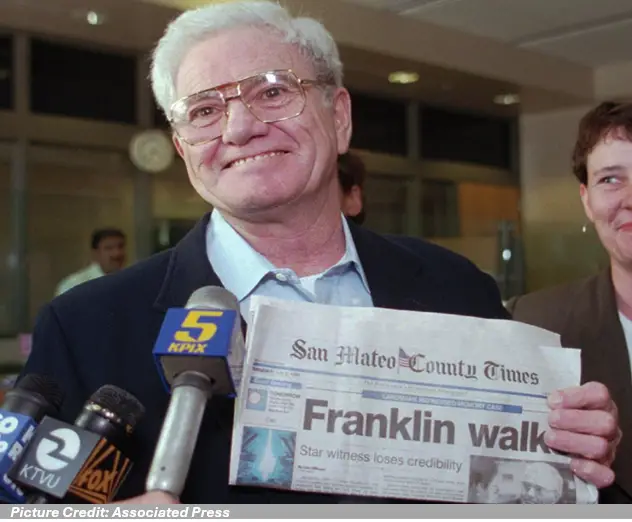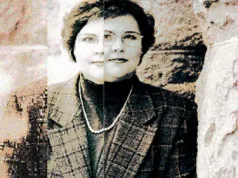When anyone looks back on the annals of court cases, the case of George Franklin will always feature among the most bizarre, unexplained and unusual cases of all time.
The case involved Franklin’s daughter recovering a memory of her father reputedly murdering her best friend – in an event she had purportedly forgotten.
What followed was a process that even to this day is heavily debated. It is considered a key case in the debate over Recovered Memories. This case is almost unbelievable, as we look into it.

Background
Eileen Franklin was 29 years old at the time of the start of this case. She was with her two children, when suddenly, after looking into her daughter’s eyes, a memory supposedly returned to her.
In this memory, Eileen saw her best friend from 21 years before – Susan Nason, being murdered. The murderer she saw in the memory was her father – George.
In particular, she saw Susan sat by a rock in the woods, and a man who had his face blocked out by the sun with a large rock above his head.
The man proceeded to hit Susan with the rock, with Susan’s eyes catching Eileen’s just before the impact. Eileen covered her ears to avoid the sound of Susan’s demise. In this moment, the lives of many would change hugely.
Eileen believed that this memory had been buried in her unconscious mind for over two decades, and that she had managed to forget it.
The memory caused total shock, and Eileen attempted to live with it through suppressing the thought. But the thought wouldn’t disappear, and Eileen was sure it was true.
The colour of her daughter’s eyes had matched Susan’s, and she believes they looked alike in that one, quick moment. She eventually told her husband, and the duo decided to call the police.
The Memory
It is important to state from the outset that the entire of this section involves Eileen’s memory – which is not necessarily true.
Eileen’s memory dated back to 1969, when she was nine years old. She says that her father George was driving her and sister Janice to school.
While driving, Eileen saw her friend Susan, and asked her father to pick her up. George did so, but asked Janice to leave the car. George drove the two girls around, but decided to skip school – deciding they should do something else instead.
They eventually drove to a wooded area, with Eileen and Susan playing with one another. As well as playing in the wooded area, they also played inside George’s van, including jumping on a mattress that was in there.
George soon joined in, though Eileen noticed at one point that her father pinned Susan down. According to Eileen, George engaged in sexual intercourse with Susan while holding her down. This was scaring Susan, and Eileen recalled a frightened look in her eyes.
Following the end of intercourse, Susan left the van crying. Eileen had crouched into a ball, trying to avoid the sight. Eileen eventually looked up to see Susan sitting a few metres away.
Then, Eileen says that she looked up, and saw her father with a rock above his head. As mentioned earlier, she reputedly saw her father George murdering Eileen with the rock.
Eileen’s father grabbed her, and demanded that she never tell anyone – threatening to kill her if she ever did. He also said that no one would believe her if she ever did tell anyone – and that she would be committed to a psychiatric facility if she did. George told Eileen to forget about it.
George dug a hole and removed the mattress from the van. Eileen did not know what happened to the mattress, but remembered urging her father to not leave Susan behind, as she would become cold overnight.
Investigation
As discussed, Eileen and her husband called the Police. Two detectives went to listen to Eileen’s account – as per the above.
The Susan Nason murder case had become a cold case. Susan’s body had been found three months after her disappearance under a mattress in underbrush off of a highway in a reservoir, with a crushed skull.
A ring and its stone were found at the site, and a blood-stained rock was as well. This all fit in with Eileen’s apparent memory above.
While visiting, the detectives were shocked by the coherent nature of the memory, and her ability to answer all manner of questions regarding exact conversations, sounds heard and the colours seen.
She even remembered a detail about Susan wearing a silver ring with a stone in it – which Eileen saw when she was putting her hands up to try and defend herself.
While the detectives entered the house with doubt, they left with the belief that Eileen’s memory was truthful.
Within a few days, George Franklin was arrested under the suspicion of murdering Susan Nason. At this point, the only evidence to suggest this was Eileen’s vivid dream of an event 21 years before. There was no physical evidence.
Legal Proceedings
George Franklin appeared in court and pleaded not guilty to murder. Both the prosecution and the defence had several arguments to offer support for or against George Franklin’s innocence. The trial would last nine days in total.
It was one of many cases in the 1990s that revolved around therapy-induced recovered memories. The topic of memory is hugely controversial.
In particular, the controversy revolves around whether or not a “recovered’ memories” can be trusted. This argument has been widely debated for decades.
During the 1990s, many people who were seeking treatment for mental distress ended up recovering memories of being abused. Many such cases were dismissed.
Therapists believed that unconscious traumatic memories were the root of the problems. Therefore, they engaged in techniques and methods aimed at “recovering” these memories.
Hypnosis, “truth serums” like powerful sedatives and guided imagery were among the controversial techniques widely used.
The prosecution’s arguments
The prosecutors aimed to secure a conviction against George Franklin. The lead prosecutor was Elaine Tipton. The prosecution believed that Eileen had repressed the memory.
The Freudian concept of repression occurs when the mind unconsciously blocks a memory from being remembered to protect a person from harm.
As the repressed memory is in the unconscious mind, it isn’t ever dealt with. But despite this, it continues to impact a person’s life and behaviour. Therefore, the prosecution cited repression as the reason behind Eileen’s case.
They didn’t ever provide any physical evidence. However, an autopsy performed on the remains of Susan found that she had died as a result of two blows to the head, consistent with a rock hitting her.
The prosecution used Dr. Lenore Terr – a respected psychiatrist – to testify as an expert witness. She aimed to tell the jury about how memories could be repressed. She said that ‘sudden, fast events’ can overwhelm a child’s defences, which can lead to detailed and clear memories.
But certain traumatic events can lead to the defence mechanism of repression to take place – meaning that the memory in question didn’t register in the conscious mind of Eileen Franklin.
When testifying in the case, Eileen told how George – an alcoholic – had been abusive to all members of the family. She said that her mother had been both physically and emotionally abused.
Eileen spoke of being ‘terrified’ of her father growing up, and that he was violent towards them growing up. She stated that her brother had kept a baseball bat near him when in his room in order to protect himself.
Moreover, Eileen stated that George had sexually abused her over a period of 11 years, but had tried to forget this. Further evidence against George Franklin came from Eileen’s sister Janice, who also claimed she was repeatedly sexually abused by George during their childhood.
Janice also testified that she believed her father had killed Susan, but that she had no facts to prove this at the time. Janice’s accounts added weight to the prosecution’s argument.
Eileen visited her father in Prison prior to the trial, asking him for the truth. George didn’t speak to his daughter, instead pointing to a sign which reminded inmates that conversations may be monitored.
George decided to not testify at the trial. The prosecution criticised George’s decision – stating that it was akin to an admission of guilt.
The defence’s arguments
The defence aimed to prove that Eileen was not adding any details to the case that the investigators weren’t already aware of.
If she didn’t give the Police any information that only an eyewitness could provide, the accusation would seem to be unreliable.
Indeed, a range of news stories from the case were read through by defence lawyers. It turned out that everything that Eileen said had been reported on already, and no new information was provided by Eileen. Yet for an unknown reason, the Judge refused for this entry to be admitted in court.
Evidence that suggested Eileen’s memory was riddled with inconsistencies was admitted into court – namely discrepancies regarding the time of day the alleged murder took place.
Eileen had originally reported that that the event happened late in the morning, or at the latest, a few hours into the afternoon. However, Susan had gone to school in the morning, and therefore she couldn’t have been picked up by George in the morning.
She even went home at 3pm, before asking to go to a friend’s house, leaving at 3:15pm. There were eyewitness accounts to prove Susan was walking at this point.
Susan’s mother Margaret became worried an hour later, and started to look around the neighbourhood for her. She eventually alerted the Police, who engaged in an ultimately unsuccessful search.
Therefore, the event would have had to happen late in the afternoon. Eileen later changed her views to reflect this, but only did so a couple of weeks before the preliminary hearing, and the court didn’t hear about this.
Eileen also altered her story about her sister Janice being in the van. She later mentioned that Janice was not in the car at the beginning.
But this seemed like a minor mistake to many. This led the defence to rely on experts in memory to form a coherent case. Esteemed psychologist Elizabeth Loftus partook in the case as a key witness for the defence.
Loftus would later recall it to be the most “bizarre story” she encountered in her career. She helped uncover a number of irregularities.
Moreover, Loftus also explained to jurors how memory could easily become distorted. Lead prosecutor Tipton told jurors that due to the complexity of Eileen’s memory, that Loftus’ studies bore little resemblance to Eileen’s situation.
Loftus was key in the defence, and stated that she believed memory could easily be manipulated, using different studies to back this assertion up [1]. At this point, she had already completed many studies into the malleability of memory.
Loftus believed that Eileen’s memory combined an array of scattered facts, mixed them with “fantasies and fears, tossed in innuendo” – leading to her arriving at the conclusion of what happened [2].
The defence had also spoken to Eileen’s brother. Eileen had told her brother about the memory soon after she uncovered it. She told him about how she had been under hypnosis when uncovering the memory. But when Eileen heard that her brother had spoken to the defence, she denied ever being hypnotised in court.
Eileen stated that she had lied to her mother and brother, and that she hadn’t actually underwent hypnosis. She said that she stated this because she thought hypnosis would add credibility to her story. The defence proposed doubt in Eileen’s recollections.
Decision
After nine days, both the prosecution and the defence rested. The jury reached a verdict on the first day of deliberations.
They concluded that George Franklin was guilty of the crime of first-degree murder. The judge in the case sentenced him to life in prison, criticising him as ‘wicked and depraved’.
In doing so, Franklin became the person to be jailed on the basis of a “recovered memory”.
Aftermath
Franklin was sent to prison to serve his sentence. But over the following years, opinion towards recovered memories would change significantly.
While the focus originally was on the depravity of so many adults, soon doubt was cast on the truthfulness of recovered memories.
The studies produced by the likes of Elizabeth Loftus appeared to show memory could easily be distorted. Moreover, plenty of cases existed where a person was sent to prison, only to be released when their accuser recanted such confessions, deeming them to be false, or “implanted” by a therapist.
A backlash started in the mid-1990s, with countless lawsuits starting over accusations that therapists had implanted false memories into patients.
Big pay-outs were awarded, including to Gary Ramona – whose daughter had accused him of sexual abuse, and Patricia Burgus – who had herself uncovered memories of being part of a satanic cult, after being under hypnosis and under the influence of a powerful sedative for a prolonged period of time. The latter was awarded $10.6million in damages.
In light of these cases, the Franklin case started to be examined again. Investigators found that the Judge had denied crucial information being admitted into the trial.
A tranche of evidence was not allowed into court by the Judge – the motivation behind this decision has never been known. This evidence showed an array of inconsistencies and patterns surrounding Eileen’s memory.
As mentioned above, Eileen’s memory provided no unique detail that would only be known by an eyewitness.
Perhaps most telling is the fact that a newspaper article hadn’t entirely written the report accurately. There was confusion surrounding the ring of Susan’s. A newspaper report suggested only one ring was worn – something Eileen mentioned when recalling her memory. But actually, Susan had two rings on.
Another newspaper noted that the mattress used was actually too big to fit in George’s van. Eileen later changed her account to suggest she couldn’t certainly tell that it was certainly a mattress. Instead she said that her father “put things” over Susan’s body.
There seemed to be too many inconsistencies in Eileen’s account, which casted doubt on its truthfulness. With convictions on similar cases being overturned, it was thought that the Franklin case may follow.
Conviction overturned
U.S. District Judge Lowell Jensen reversed the conviction of George Franklin – stating that the “risk of an unreliable outcome in this trial is unacceptable”.
Jensen stopped short of denouncing recovered memories, and stated that they could continue to be used in trials.
A litany of errors from the judge in the case also led to the overturning of the original ruling. Jensen found Franklin’s lawyer was blocked from showing news articles from the time that bore total resemblance to Eileen’s memory.
This would’ve showed that as an eyewitness, Eileen didn’t offer anything that investigators didn’t already know. This was deemed to be crucial enough to merit the conviction being overturned.
The district attorney mulled over whether or not to retry Franklin. They had no doubt in Franklin’s guilt, but realised that trying to convince a jury beyond a reasonable doubt that George Franklin did murder Susan Nason would be difficult – especially given the fact their only evidence was a memory that had been recovered.
They eventually decided not to proceed with a second trial, and Franklin became a free man. This was a very difficult decision – with many people in full belief that George Franklin was culpable for Susan’s death.
Eileen Franklin’s later allegations
Eileen Franklin became a celebrity for a short period of time – making appearances on talk shows and holding regular interviews.
She would go on to write two books on the case. Others have written biographies of the case, while many academic journals have compiled research analysis on the case.
Eileen later recalled two further murders that were purportedly committed by her father – but DNA testing confirmed George Franklin’s innocence on these cases.
Legacy
As the first case that involved a conviction based on a recovered memory, the George Franklin case became well-known. The landmark decision of Franklin’s guilt served as a precedent for many other cases to follow.
Yet the overturning of the conviction was also a key moment in the overall argument on recovered memories. Subsequently, it became clear that recovered memories were not enough evidence in courts of law.
Around this time, media interest in recovered memories was peaking. This was one of many high-profile cases. Others included the infamous McMartin preschool abuse trial, the ever-controversial False Memory Syndrome Foundation – which featured the Freyd family, and allegations of satanic ritual abuse. The case of George Franklin is held in the same esteem as these other notorious cases.
The Franklin family became fractured. George and his wife Leah were already divorced. Leah revealed that she had asked George if he had murdered Susan a few years after the young girl’s death.
However, while Leah originally wholeheartedly supported Eileen, she later stopped believing in the truthfulness of her daughter’s memory.
George Franklin later sued his daughter and the expert psychologists that had testified against him in the trial. The lawsuit was dismissed however.
Little is known of what happened after with George, with next to no information available regarding what happened to him after the case. He would later pass away.
Loftus would later state that the jury had all but made up their mind on the case before she had the opportunity to testify. She said how repression was something that needed a “leap of faith” in order for someone to believe it.
Those who took that leap could not be dissuaded in their opinion by Loftus’ scientific arguments. She stated that her testimony was just an “inconsequential detour” towards the juror’s decision [2].
Summary
In the modern day, debate continues over recovered memories. Generally, recovered memories are treated with doubt, and require further corroboration to merit their inclusion in a trial. Any therapy that aims to uncover past memories are also frowned upon by psychiatric professionals.
Unfortunately, it is rarely possible to see if a person’s memory is or isn’t true. As many innocent people were convicted, memory became a controversial topic. Doubts will always remain over this case, and whether or not George Franklin really did murder Susan Nason.
Whether Franklin got away with murder or not will probably never be known. Susan’s poor parents have been left with an unanswered question. The case was full of them, and will forever be remembered for being a landmark, if bizarre case.
VISIT OUR RECOVERED MEMORY BLOG
Disclaimer
This website should be used purely for informational purposes, and does not intend to, nor should it ever, be used as a replacement for professional medical advice.
We strive to keep all of our pages updated, and ensure that our website is full of factual and in-depth information. However, we encourage you to browse this website with care.
As a reminder, this website and all content within it cannot and should not replace the advice of a trained medical professional. You can read our full disclaimer at this link.
Helplines
If you are struggling with your mental health, help is available. With the right support and treatment, you can make a recovery. For information on helplines, or if you are in a state of crisis, please visit our crisis page by clicking on the relevant link for your geographical location (United Kingdom), (United States), (International). You can also see how to get mental health treatment and the process involved by clicking this link.
References
[1] Loftus, E. (1993). The reality of repressed memories. American Psychologist. 48 (5), p518-537.
[2] Loftus, E. & Ketcham, K (1994). The Myth of Repressed Memory. New York: St. Martin’s Press.


































